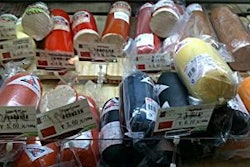.jpg?auto=format%2Ccompress&q=70&w=400)
Back in 2006, the managers at Hy-Line North America (HLNA) started planning a new hatchery to primarily focus on the West Coast, but one that would also be within reach of the Midwestern markets. The decision was made to build in Burley, Idaho in the southern part of the state, strategically located near major interstate highways.
The selection of Burley was all about the location: to reach the West Coast. However, Burley also has an agriculture-friendly environment, a strong employee base, and good geography.
The new hatchery would cover two other hatcheries: one in Lakeview, California that hatched 11.5 million chicks a year, and had been part of HLNA for 40 years; the other in Graham, Washington, originally built in 1984, and which HLNA has used for seven years, producing five million chicks a year.
The Burley hatchery was built for expansion purposes, to better service the West Coast clients, yet still able to supply the Midwest. The hatchery was built to full capacity, with no immediate expansion planned for the facility.
HLNA approved the final plan in the spring of 2008 and ground was broken for the hatchery in October that year. It was an aggressive plan, seeing that not only would Burley have a much greater capacity than the hatcheries in California and Washington, but the new hatchery would also incorporate the latest incubation, ventilation and automation technologies.
The first hatch in Burley was on April 15, 2009. The new hatchery, with a floor area of 74,000 square feet, has a capacity of 100,000 pullets five days a week, which equates to 26 million pullets a year. By June 2009, the California and Washington hatcheries were able to stop hatching and the one in California was closed.
The Burley facility hatches Hy-Line and Lohmann pullets, seeing that HLNA is a distributor for both those breeds. At this point, the breeders are all in the Midwest and the eggs are brought in, but very soon Burley will have its own breeders. They will be starting breeder operations this spring, and will house enough birds for 40-50% of their needs.
The majority of the eggs hatched are white, with brown egg production on the West Coast having declined over the last 15 years, now standing at 10-15% of the total.
From the perspective of the managers, the Burley hatchery is there to meet the demands and needs of their customers, whatever those may be. The plant is manned by 51 hourly employees and four managers.
Technology
The featured technology of the Burley hatchery is single-stage incubation, making it one of the most modern hatcheries in the US. They use 60 Chick Master Avida A-12 setters and 24 Chick Master hatchers.
According to Burley’s hatchery manager, who has worked in hatcheries his whole life, embryology in single-stage machines is significantly different than in multi-stage. There is a better ability to control CO2. The biosecurity aspect is also improved, with the machines being much easier to clean.
There is a different mentality in running single vs. multi-stage machines. Once the single-stage setter has its profiles established, it is much easier to use and the efficiency is greater.
Changes are made at the hatchery to maximize performance, as the changes in genetics improve. Single-stage incubation gives the ability to make those changes. Changes to the profiles can be made every day.
All the machines are monitored through a remote computer. Changes can be made from the central location or remote areas to the machines and the room environments.
The area above the machines, where the pipes and wires run, is very large and accessible, making maintenance in that area very easy.
All of the rooms have added humidity, in order to add moisture when needed. Pressures are used depending on the room’s required airflow.
Sustainability
The Burley hatchery has taken energy savings very seriously and has established sustainable practices at every level possible. There is motion activated lighting in the whole facility, for example.
Hatchery waste goes to a local composting company. Chick down is captured behind the hatching rooms and is easily collected for disposal. HLNA wants the Burley hatchery to be there for the long term, and they know they have to be as environmentally friendly as possible.
The primary heat recovery system is the highlight of Burley’s sustainability practices. There is a sealed loop that takes cool water to the setters, and on the return loop, that water is warm. Software then determines a difference in the temperature of the water and the outside air. The water goes to the rooftop and runs through heat exchangers, which capture that excess heat for the various rooms of the hatchery.
The managers know that the energy savings are significant.
All the mechanical and ventilation systems in the plant were designed by Hatchery Planning Company, including the heat recovery system.
Biosecurity
The biosecurity features are quite thorough, starting with a single entry and exit point, 10 showers for entry and the ability to shower in and out. Disinfectant foot baths are located at the entry points to the various rooms.
Clean and dirty areas are clearly marked, and the production flow maintains the highest level of biosecurity. There are high pressure hoses located in all hallways and rooms to facilitate the highest level of sanitation.
Automation
This is a highly automated plant: destacker, separator, in-line tray washer, sexing table, and vaccination. Birds are still manually sexed, however. Vaccinations are done according to the customer’s wishes.
Transport
The Burley hatchery has its own transportation fleet with six trucks. California, Washington, Oregon, Utah, and New Mexico all get their pullets within 24 hours of hatch. The goal is to have all chicks delivered with 24 hours of hatch.
They use Smithway trucks especially modified for transporting chicks. Each truck holds over 100,000 chicks and has monitored airflow and temperature control. The trucks have their own generators for providing environmental control for the pullets.
There are separate docks for clean trucks and returning dirty trucks, one more piece of the overall biosecurity plan. The dirty dock has a truck washing area.
They usually schedule loads three weeks out, but their orders are booked one and sometimes two or three years in advance. However, they are still able to accommodate short-notice orders.
Quality Control
There is a full time Quality Control manager, who monitors a large number of aspects in the plant. They also have compliance managers who audit for SOPs, animal welfare and safety.
The focus of the Burley hatchery is to send a quality, healthy product to the customers. The emphasis is on supplying all customer orders, be they large or small, on time and exactly as requested.
The use of the most advanced hatchery technology available goes a long way in allowing the Burley hatchery to accomplish its objectives.






.jpg?auto=format%2Ccompress&fit=crop&h=167&q=70&w=250)











